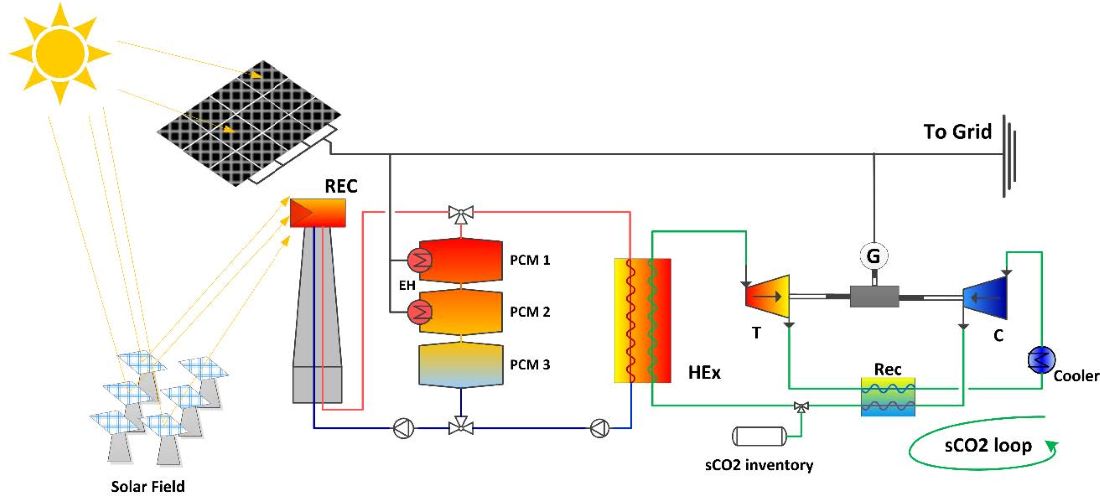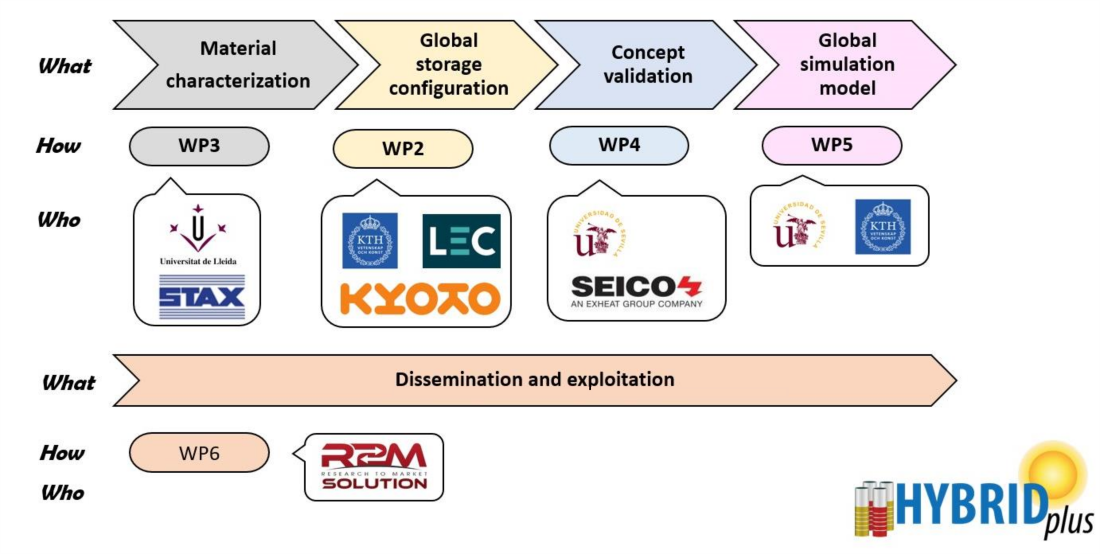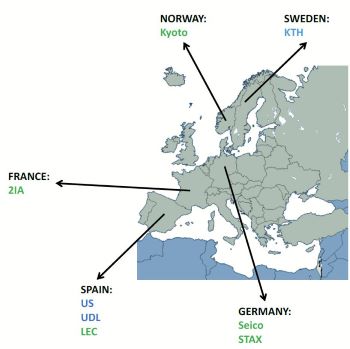HYBRIDplus – Advanced HYBRID solar plant with PCM storage solutions in sCO2 cycles
HYBRIDplus aims to pioneer the next generation of CSP with an advanced high-density and high-temperature thermal energy storage (TES) system capable of providing a high degree of dispatchability at a low cost and with a much lower environmental burden than the State of the Art. This thermal storage is based on the Phase Change Material (PCM) technology in a cascade configuration that can reproduce the effect of a thermocline and integrates recycled metal wool in its nucleus. This enables hybridization with PV by acting as an electric heater transforming non-dispatchable renewable electricity into thermal stored energy ready to be dispatched when needed. HYBRIDplus proposes a novel concept to hybridize PV+Cascade PCM-TES with CSP configuration based on a high-temperature supercritical CO2 cycle working at 600 ºC. This new plant is called to form the backbone of the next-generation energy system thanks to higher efficiency and lower LCOE than state-of-the-art technology.

Background
The state-of-the-art CSP system is the molten-salt solar tower, which uses solar salt (HTF) at temperatures up to 570 °C. EU SET Plan [1] and agendas target significant cost reductions, coupled with the new development of HTFs, storage technologies, and power systems able to reach thermal efficiencies higher than 50%. Thermal energy storage (TES) is a key component of CSP plants, ensuring flexibility and power dispatchability; however, TES accounts for about 12-17% of the CAPEX in traditional CSP plants [2]. To achieve the SET Plan goal, a 30% reduction in the TES specific cost is necessary [3]. Each technology shift (e.g. HTF, TES, and power block) will have consequences on the CSP plant, with high risk for developers and financiers. Therefore, a step-wise approach where key sub-systems and components of the novel já system are individually developed, optimized, and tested before their full integration is of utmost necessity to push innovations in CSP [4]. Such an approach allows assessing technologies under controlled environments where external boundary conditions can be emulated (e.g. weather), and where components can be optimized gradually by progressively testing these at more challenging operating conditions (e.g. temperature and pressure) and under a number of cycles, while simultaneously allowing for data to simulate and evaluate integration and control aspects. Financing high-risk technologies is highly challenging, and progressing towards the EU SET goals in steps that the CSP industry members can support and implement is essential for the health of the industry and the commercial viability of newly developed technologies.
Aim and objectives
- To develop and validate at TRL 4 a PCM-cascade TES concept with a cost below 12 €/kWht for CSP applications with advanced sCO2 cycles;
- To design, prototype, test and validate an electric heater using integral metal wools into a PCM composite to charge the TES with surplus renewable electricity from the grid;
- To reduce LCOE by 10% compared to state-of-the-art CSP technology, reducing by 20% the capital cost of the TES and by 15% the O&M costs thanks to the higher power block efficiency;
- To reduce the carbon footprint by 10% against state-of-the-art CSP plants;
- To enable the fully renewable grid paradigm in Europe, developing a solar power generation technology, which can achieve capacity factors up to 80 %, and 99% dispatchability.
KTH's main role: KPIs for the storage system. Techno-economic model. LCA and s-LCA. Development of the exploitation activities HYBRIDplus's overall view and methodology are summarized in the figure below.

Project partners

KTH Royal Institute of Technology (Sweden);
Universidad de Sevilla (Spain);
Universidad de Lleida (Spain);
Limiren Consulting SL (Spain);
Kyoto Group AS (Norway);
SEICO Heizungen Gmbh (Germany);
STAX - Deutsches Metallfaserwerk DR. Schwabbauer Gmbh & Co. KG (Germany);
R2M Solution (France).
Funding is provided by European Union’s HORIZON EUROPE Research and Innovation Programme under the Grant Agreement No: 101084182.
Timeframe: 2022 - 2026
Publications
Innovation trends on high-temperature thermal energy storage to defossilize energy systems
Researchers
References
[1] Commission E. SET-Plan - Declaration on Strategic Targets in the context of an Initiative for Global Leadership in Solar Thermal Electricity ( CSP / STE ) 2015.
[2] IRENA. Renewable Power Generation Costs in 2020. 2020.
[3] Murphy C, Sun Y, Cole W, Maclaurin G, Turchi C, Mehos M, et al. The Potential Role of Concentrating Solar Power within the Context of DOE’s 2030 Solar Cost Targets. NREL Tech Rep - NREL/TP-6A20-71912 2019:137.
[4] Turchi CS, Ma Z, Neises TW, Wagner MJ. Thermodynamic Study of Advanced Supercritical Carbon Dioxide Power Cycles for Concentrating Solar Power Systems 2013. https://doi.org/10.1115/1.4024030.
